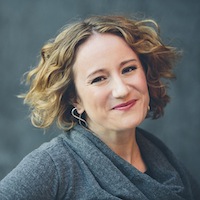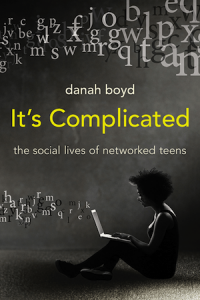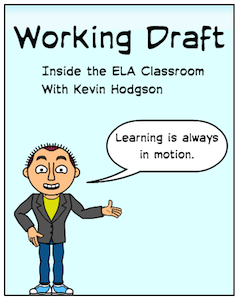Teen Life Today: It Sure Is Complicated
A MiddleWeb Blog
Dr. danah boyd chose an excellent title for her new book about her research on young people and technology: It’s Complicated: the social lives of networked teens. She’s right on the money: it sure is complicated. Not the book, which is a wonderful research-infused dive into the world of teenagers and technology and digital expression, but the world in which we teach and parent and live.
Drawing on extensive interviews with hundreds of young people over a number of years, boyd brings to the surface what it means to be a teenager in the early decades of the digital age, and therefore, what it means to be a teacher of these students, now and into the near future.

“Educators have an important role to play in helping youth navigate networked publics and the information-rich-environments that the internet supports. Familiarity with the latest gadget or services is often less important than possessing the critical knowledge to engage productively with networked situations, including the ability to control how personal information flows and how to look for and interpret accessible information.” (p. 180)
Curiosity & discovery comes with mistakes
Thankfully, boyd also dispels the whole notion and dichotomy of the “digital native” concept, as if young people have some natural abilities to navigate and use technology in a meaningful way. They don’t. What they do have is natural curiosity and a willingness to dive into the unknown, figuring out how a website or app or device works on the go. This can lead to discovery, and to mistakes. By focusing on the mistakes, we lose sight of the powerful potential of technology.
In fact, boyd calls the labeling of kids as “digital natives” dangerous on a number of levels, including her legitimate concern that by doing so, we ignore the issues of equity and access that is creating a “participatory divide” along racial and class lines in our country.
The loss of traditional social space
As parent of two teenagers and as a teacher of pre-teens, I took away a lot of information from It’s Complicated. First and foremost is the idea that young people have less and less access to public spaces and time in which to socialize with friends and peers. The days of our moms and dads kicking us outdoors in the morning and saying, “Don’t come back until dinner time” are over. Ballfields remain empty during the day. Malls and shopping centers are less teen-friendly than ever, with some resorting to strict policies about congregation and others using high-pitched noise generators to make the spaces unpalatable to kids.
Wandering the neighborhood for hours at a time is no longer an activity allowed by many families. Fear has cast a protective net over everything kids do. Children’s days are over-scheduled with sports, arts, functions and additional classes. Yet the need to connect and socialize has not gone away in these overly adult-managed times.
The urge to socialize

Many of the young people interviewed here said they would actually rather be hanging out with friends in real spaces than posting updates in online spaces, but the hemmed-in reality of their lives makes that nearly impossible. They use what they have to meet the urge to socialize, however. They use Facebook, and Twitter, and Snapchat, and other platforms.
It’s Complicated explores many of these cultural fault-lines – including the way news outlets portray teens and technology in such negative light; the issues of cyberbullying versus what kids call “drama”; the way social spaces amplify both the positive and negative aspects of human nature – and issues a call to all of us who are adults to take more time to understand the shifts now taking place.
7 take-aways from danah boyd’s work
As a teacher, here are some of my take-aways from boyd’s important book. We need to:
- Acknowledge the role that networking spaces play in the social lives of teens and provide the framework for helping students understand the dynamics of those spaces as a means of connection and communication;
- Provide more time for shared learning experiences in their lives, tapping into the social spaces of students in ways that acknowledge the strengths of those connections;
- Come to learning from a positive position, not a negative one driven by fear of the world and fear of the unknown;
- Understand that social media sharing is in a context that we adults often don’t understand completely, avoid making judgements about a single image or tweet or post, and be open to how “posturing” in some spaces can be a survival technique for some students;
- Recognize how different online spaces can shape or nurture prejudices and access, so that when white/upper class students flock to Facebook and minority/lower class students remain in MySpace (a phenomenon that boyd noticed a few years ago), the opportunities for education and careers don’t get narrowed;
- Teach explicitly what it means to find information and understand media influence in online spaces, so that students understand the pros and cons of the communication, and they can learn how to make judgements about the validity of that information with informed eyes;
- Listen to what teenagers are saying about the complexity of their daily existence, because their voices are important in any educational landscape where learning is not about the moment, but about their lives.
I highly recommend It’s Complicated to my fellow teachers, whether you have teenagers in your classroom now or not. The research and boyd’s insights will open up your eyes to how complex the world is for children to navigate, and how so often they are figuring it out on their own, making mistakes as they do so.
We teachers are not “digital immigrants.” We are their guides, and our role, along with parents, has never been more important, nor more complicated.



































Great insight into the need for physical spaces for socializing that allow students to interact face to face. We often overlook the power of inviting and supportive physical spaces that allow teens to put down their devices and be kids.
Love your post. Very insightful and eye opening.
Thanks for taking the time to comment, and I am hopeful some of boyd’s research filters out and informs us about how we might approach understanding the digital lives of our students in our classrooms (or our children in our families).
Kevn
I come to this as both parent and teacher, and I’m loving the way boyd lets the kids voices shine through. I think this is such an important piece of understanding our kids, and the way they communicate, and helping us guide them without shutting the conversation down,